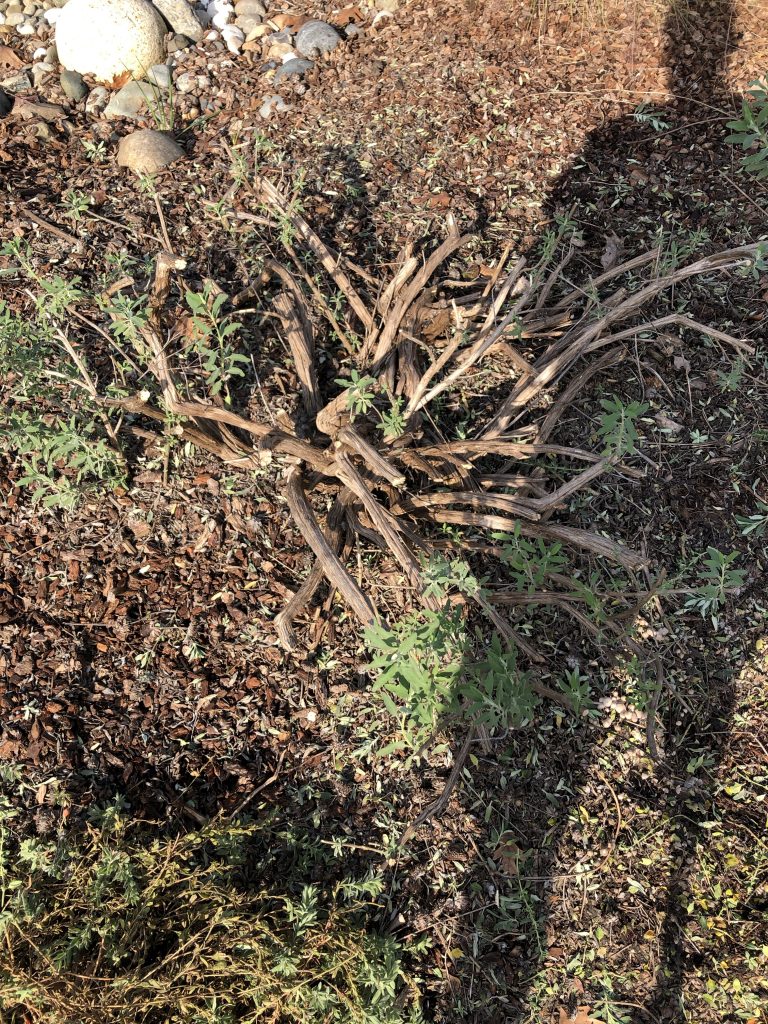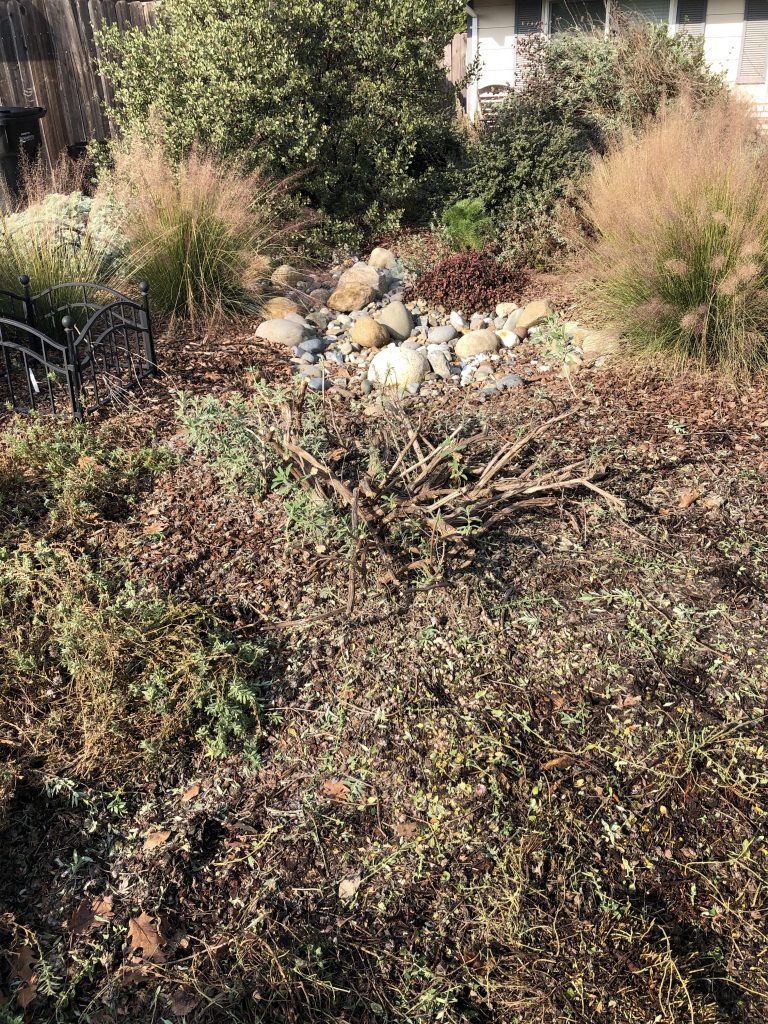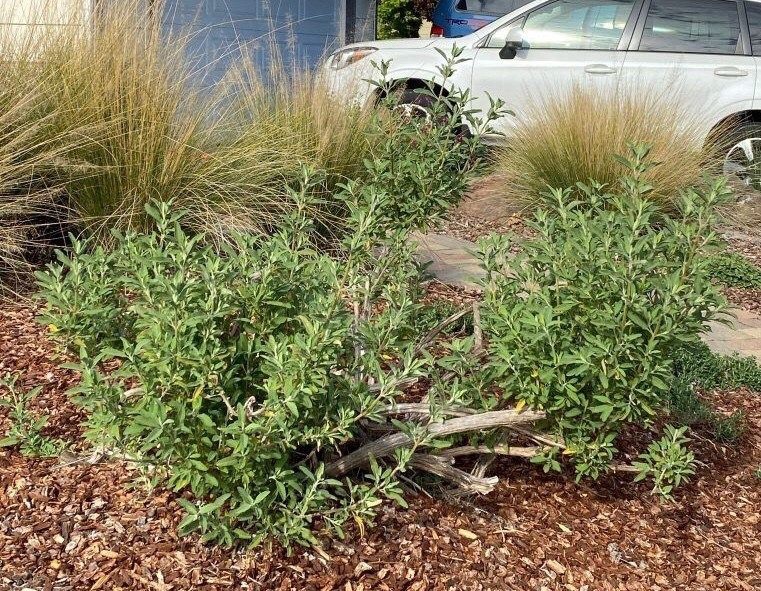
Chasing Your Pozo Blues Away
By Taylor Lewis, nursery manager
Hello again! Back in January, 2020 while doing some winter cleanup for a client, the question arose of what to do with a huge, happy Salvia ‘Pozo Blue’. Can it be pruned? How far back? Do it in stages to avoid shocking the plant? Just deadhead spent blooms?
Salvia ‘Pozo Blue’ is a California native sage cultivar that has both Salvia leucophylla and S. clevelandii parents. He is best suited to an open, full (or mostly full) sun environment. Blooms usually appear in late May to early June; papery whorls adorned with lavender blue flowers show their wares off to the bees and butterflies. Pozo can reach 5 feet high and 7 feet around. This one was about 3 1/2 feet x 7 feet.
Pruning Time: Evaluate the Situation

I’ve pruned many Salvia over the years and, almost without exception, found that I can whack as hard as I want without detriment to the plant. 98% of all the mature sage in the size range of 3-6 feet that I’ve pruned down to 6 inches -1 feet have come back better, fuller and happier than before reconstructive surgery. All that to say, “I’m going to take this bad-boy to the ground”, with confidence and it will be just fine.
Often, I can see where to begin pruning at first glance. Other times, I need to cut into the plant to view the situation more clearly. I start my cuts on a non-visible side, just in case. Once I can see the structure in the center of the plant, I can sit in the new pie-shaped opening and use my loppers to prune 90% of the plant without having to change positions. I can reach through to the front sides easily and look for new, emerging growth to line-up my cuts.
Prune Back 90 Percent, Don't Be Shy

You’ll notice that many of the remaining branches don’t have any green at all. Scared? Maybe uncomfortable? Pirate guy lost his mind? If this were a lavender, I wouldn’t dare be so brazen as to attempt that severe of a cut…Unless it was a ‘Goodwin Creek Grey’, they can usually take it.
*** In fact, as a side note, if that were a lavender, I would still have pruned hard, but only down to the green. If you start at the tip of each branch and work down towards the center of the plant, you’ll always be able to find the lowest bunch of green; leave that intact by pruning just above it by 1/4 of an inch. It might be time for a Lavandula lesson. ***
Back to the Salvia. When I came across a branch with fresh growth, that was lower on the plant, I cut just above it. Once our Pozo pushes from the base, I could cut back even harder to help control how big she grows this year.

Things to Note
- Salvia are generally a very forgiving plant. If you’re going to sharpen your skills, Salvia makes a good test subject.
- Now would be a good time to fertilize if the plant needs it. How can you tell? Scroll back up to the top and look at the first picture. Bloom looked strong, color looks great, obviously growing well, I’m going with “no”. However, I left behind plenty of leaf litter and the bark seems to be decomposing well. Knowing my clients, they don’t use herbicide or pesticide and I’m sure that they have a healthy soil biome existing below. That means that organic material will cycle through its process of breaking down into plant food quickly.
- try to include the tools that I use for each project in one of the pics. Felcos and loppers for this job. Not much detail work involved, you can see the scarcity of numerous twigs near the center of the plant.
- Pozo pushed out new growth very quickly but remained small until the past two weeks. Was it protecting new baby leaves from potential frost damage? Was this because we had a dry winter? Even little leaves photosynthesize and it must have been storing up some energy. Two weeks ago it popped and burst into spring.
- This is a very low-maintenance plant. You could get away with pruning this plant once a year. You could prune it every other year and you’d also be fine. If you let it go 3 or 4 years then the job is a bit harder and seems more challenging.
- This particular sage went into the ground, fall of 2012. It had minimal inputs as far as water, fertilizer, and maintenance (some deadheading) but no major pruning was done until the spring of 2019. At that time, it got a 1/4 trim, or what I like to call, “a little off the top”. So, this was its first serious prune.
March 2020 Update

It makes me happy to see this. Amy, I really appreciate the photo evidence and the record keeping. Your garden is beautiful. Fresh bark mulch really shows off the color. Fingers crossed for an amazing bloom to come.
If you wanted to keep Salvia ‘Pozo Blue’ a bit smaller this year, now that it’s pushed so nicely, this would be an appropriate time to cut everything back by half while spring is treating us so well.
Be well. Stay safe. Spend some time connecting with your plants. See ya next time. I love comments; they bring me joy.
